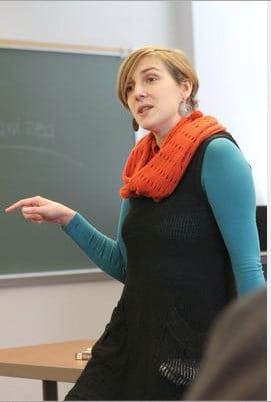What Does “Back to Normal” Mean for Schools? (by Agata Szczeszak-Brewer)

Agata’s son enjoying time at the lake. [image description: In the lower right corner, a young boy sits with his back to the camera. He has light skin and short blondish hair. He is looking out over a lake surface that is rippled and dappled with sunlight. There is a branch with small green leaves in the lower left corner, and there are tiny water snakes in the middle of the photo.]
As the mother of a medically complex child, I was stunned by a recent Facebook post by a scientist friend who is cautiously advocating for dropping mask requirements in schools. He’s posted the recently released “Urgency to Normal” toolkit. My friend reminds us that he “was all-in at the beginning,” that he even got heckled at a school board meeting when he defended mask mandates. But, he says, he’s not sure he would push for school masking now.
I’ve lived through the pandemic in Indiana, where many people refuse to wear “face diapers” and spread conspiracy theories about “plandemic,” horse dewormers, and microchipped vaccines. County councilmembers advocate against vaccines. Indiana’s vaccination rate hovers just over 53%. My county has a 47% rate. In Montgomery County, where I live, masking in schools seems to be the only mitigation tool we have, since our shops, restaurants, and churches are crowded and mostly unmasked and unvaccinated.
My scientist friend writes that Omicron is both more contagious and milder than previous variants. There’s only weak evidence for masking in school settings, he says. Everyone 5 and older has had a chance to get vaccinated, and the risks for younger kids are minimal, he says.
But what about children like mine? Those who are medically complex? Those who are disabled? Those too young to be vaccinated? What about the most vulnerable among us, the immunocompromised or those with comorbidities? Is masking properly in public places too much a sacrifice for the community as a whole to protect the most vulnerable during future Covid surges? Scientists say Covid won’t be going away any time soon.
I am struck by the toolkit’s lack of consideration for people like my child. The name of the advocacy group itself, “Urgency to Normal,” has a eugenicist tone. I find the “healthy children don’t have to worry” rhetoric troublingly unconcerned with children who cannot rely on their own immune systems. The toolkit’s authors don’t seem to consider questions of equity in terms of disability.
I, myself, grapple with the implications of face coverings for children who have hearing impairment and those learning to read and speak. This is why I am advocating for nuance rather than rigidity or a one-size-fits-all approach to Covid.

Agata in the classroom. [image description: A woman with light skin and short blond hair wears a black jumper over a teal long-sleeved shirt. She has a large orange scarf draped around her neck, and she wears large bronze-colored earrings. She is gesturing toward a large chalkboard in the background.]
Why not change masking requirements on a school-by-school or county-by-county basis when community spread reaches, say, a 10% threshold? According to the CDC, that’s a “medium” transmission rate. However, the CDC only recommends schools require masks when the transmission rate is “high,” which is a 20% transmission rate–and CDC rates are linked to hospital admissions and capacity. As we know by now, hospital admissions are not the earliest indicator of high community transmission rates. A “medium” transmission rate more accurately reflects high community spread. We also ought to consider wastewater testing and comprehensive school-based testing as important triggers for mask requirements.
Many people are concerned about students who are learning to read, or teachers in classes with hearing-impaired students. Removing masks puts these students at risk during high transmission periods. Schools should invest in the many anti-fog, clear panel masks now available.
We don’t have to follow rigid guidelines, but we need to take into account the safety and well-being of all students, including the large portion of them who are immunocompromised. Are deaths or the real threat of long Covid among young children, people with disabilities, and immunocompromised persons admissible collateral damage in this “Urgency to Normal” drive? Shouldn’t the toolkit’s authors wrestle with such complex issues, too?
If more people were properly masked in public spaces, children and adults with disabilities could participate in society without fearing for their lives. Since this is not happening, let’s focus on safety in schools, one of the most essential places for our children to thrive.
Disability activists fought for a redefinition of “normal” even before the pandemic to make our society inclusive of those with impairment. It’s time we collectively address what “normal” means, whom it excludes, and why we’re ok excluding large groups of both vulnerable and valuable people from taking part in public life.
Agata Izabela Brewer is a Polish-American scholar, writer, teacher, and activist. She chairs Immigrant Allies, a branch of Humans United for Equality, a non-profit organization in Indiana. She is also a Court Appointed Special Advocate.
